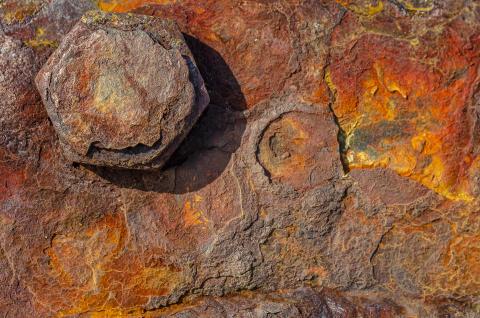
Biocorrosion of nuclear waste storage and metals
A team of scientists, some of whom from the Archaeomaterials and Alteration Prediction Laboratory (LAPA) from the unit of Nanosciences and Innovation for Materials, Biomedicine and Energy (NIMBE – University of Paris-Saclay, CEA, CNRS), is developing a new approach to determine the origin of corrosion of ferrous metallic materials and identify the contribution of micro-organisms.
The corrosion of metallic alloys in soil or water cause industrial installations to deteriorate. Corrosion phases concerning nuclear waste storage areas require specific designs for this part of the installation. In the environment, these installations are in contact with multiple micro-organisms which contribute to metal corrosion. For example, sulphate-reducing bacteria convert sulphates from the surrounding environment into sulphide, with an effect on corrosion trends.
LAPA researchers from the unit of Nanosciences and Innovation for Materials, Biomedicine and Energy (NIMBE – University of Paris-Saclay, CEA, CNRS) have recently studied iron corrosion caused by this bacteria in collaboration with the National Museum of Natural History of Paris, the Institute for Radiological Protection and Nuclear Safety (IRSN), the National Agency for Radioactive Waste Management (ANDRA) and the University of Pau.
In their experiments, they analysed the corrosion products formed in a composition environment similar to soil, in the absence of bacteria (abiotic environment) or presence of bacteria (biotic environment) at different times. To come closer to environmental conditions, the researchers also performed an experiment with a biotic phase followed by an abiotic phase.
Thanks to a very precise technique of mass spectrometry based chemical imaging, nanoSIMS, they quantified the 34 and 32 sulphur isotopes – 34S and 32S – contained in sulphides precipitated in iron corrosion products. In general, sulphate-reducing bacteria preferentially metabolises 32S and the proportion of this isotope is much greater than that of 34S in a biotic production of sulphides. The results obtained by the researchers for iron corrosion in the presence of sulphate-reducing bacteria are consistent with this fact.
The team also proposes a methodology for fine detecting iron corrosion and its biological or geological origin, adapted to iron sulphides in corrosion products on a micrometre scale. This technique may be applied in preventing the risk of corrosion of metallic materials, particularly in nuclear waste storage sites.
Publication:
Grousset S., et al. "Biocorrosion detection by sulphur isotopic fractionation measurements." Corrosion Science (2019): 108386.
